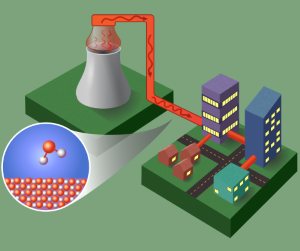Catalysis for Better Control and Use of Thermal Energy
by Gregory Schenter

In order to have a thermal grid in the future, we must explore technologies at a molecular level. HEATER will unify electron, photon, chemical, and heat driven phenomena. credit: Rose Perry | PNNL
In the 19th century, researchers derived the fundamental mathematical laws governing conversion of thermal heat into useful work, and the field of thermodynamics was born. Applying thermodynamic principles increased heat engine efficiency and accelerated the industrial revolution. Today heat storage and transfer still remain central to modern society. More than two-thirds of U.S. primary energy production is rejected to the environment as heat. Reducing these losses represents a unique opportunity to lower energy costs and increase U.S. competitiveness.
Now a new U.S. Department of Energy (DOE) initiative is taking on this challenge. The Highly Efficient Advanced Thermal Energy Research (HEATER) Program aims to transform the conversion, storage, transmission, and utilization of thermal energy. Once new technologies are developed and fully implemented, HEATER could enable a thermal grid infrastructure similar in scope and scale to the electric grid.
Catalysis science will be an important contributor to the HEATER mission. Currently, our ability to control and manipulate heat lags significantly behind other forms of energy such as electricity and light. Chemical transformation and catalysis research involves studying conduction, phase change, heat transfer, thermal storage, and conversion between forms of energy such as chemical bonds, electricity, light, and heat. These areas are critical for the HEATER project.
Building a thermal grid requires that we develop a new class of thermal analogs for familiar electrical devices, such as thermal batteries and switches, converters that use heat to produce power or cooling, step-up and step-down thermal transformers, more efficient thermal insulators and conductors, and more.
But we still have many basic questions, including: Can a transistor be developed to control heat flow? Can high temperature heat sources be nearly losslessly transported over long distances? Can we advance beyond copper heat exchangers? We need integrated solutions to address the range of temperatures (<100°C to >1000°C), diverse physical scales (microchip to regional), and wide variety of sources (mobile, intermittent, etc.) that are required for effective heat storage, conversion, and transfer.
HEATER aims to address these questions by building a cross-disciplinary team. This team will address questions that are similar to those in the catalysis field. For example, researchers need to understand the connection between molecular detail and larger scale collective phenomena that must be tuned and controlled. Also, we cannot solely study systems that consist of homogeneous materials. Opportunities arise when we understand emergent phenomena associated with complex, possibly hierarchical structures involving a mixture of materials and phases. Finally, these studies will help us better understand how chemical transformation and mass transport are connected.
We can make significant strides in addressing these research question because of our advanced capabilities to 1) develop theoretical frameworks that establish how molecular detail and macroscopic processes are connected, 2) synthesize well-characterized and measurable systems, and 3) take advantage of advanced characterization and spectroscopic techniques. With these capabilities, the HEATER Program will be able to design and implement more effective and efficient systems.
"Within five years, HEATER hopes to answer the basic science questions and develop new technologies that will lead to superior thermal performance in diverse U.S. energy markets," says Dr. Darren Mollot, Associate Deputy Assistant Secretary in DOE's Office of Fossil Energy. The ten-year goal of this project is to gain 10% more beneficial output from currently rejected thermal energy resources, representing the equivalent of generating an additional 50 billion gallons of gasoline annually. Energy in the form of heat will be stored and utilized instead of being wasted, which will lead to more efficient generation, transportation and end-use, and lower energy costs. This will strengthen the U.S. economy and secure our energy future.
Gregory Schenter is a physical chemist at Pacific Northwest National Laboratory whose research interests include the development of statistical mechanical techniques to better understand molecular interactions and molecular processes in complex condensed-phase systems.

